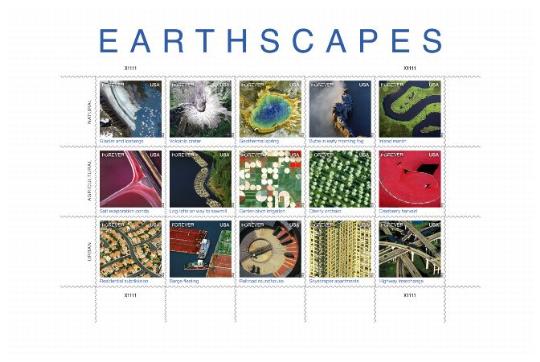
To kickoff October as National Stamp Collecting month, the Postal Service™ will issue the Earthscapes Forever® stamps on October 1, 2012, at NASA’s Goddard Space Flight Center near Washington, DC. Postmasters are encouraged to conduct special dedications ceremonies — especially near stamp subject locations and where the photographers reside.
Inviting the photographers to participate in an event is a tremendous media draw. Contact photographers unable to attend events for the backstory on the stamp before pitching them to local media as a phone interview to add value to the event’s news coverage. Corporate Communications area managers are available to assist in publicizing activities.
This publicity kit includes the following:
n Earthscapes stamps, photographer, and location background.
n Sample media advisory.
n Sample news release.
n Sample speech.
n Contacts for obtaining stamp images for use in events.
n Corporate Communications area managers listing for assistance in contacting media.
n Government Relations contact listing for assistance in inviting elected officials.
Earthscapes Forever Stamps and Photographer Background
The stamp pane features 15 stamps in three rows of five. The top row shows five examples of natural earthscapes. The middle row focuses on a wide range of agricultural earthscapes. The bottom row shows urban earthscapes. In all cases, art director Howard Paine chose photographs to showcase designs, patterns, and geographic diversity.
The Earthscapes Forever stamps allow customers an opportunity to see the world in a new way. This stamp pane presents examples of three categories of earthscapes: natural, agricultural, and urban. The photographs were all created high above the planet’s surface, either snapped by “eyes in the sky” — satellites orbiting the Earth — or carefully composed by photographers in aircraft.
In the top row, we fly over America’s stunning wilderness. While a volcanic eruption scars the forests of Washington State, fog drifts over the timeless sandstone towers of Utah’s Monument Valley. In Alaska, a wide stripe that looks like a highway is actually a glacier, an immense conveyer belt of ice. At its base, jagged white shards resembling broken glass are really icebergs, bobbing in a lake.
The stamps in the center row may look like abstract art, but they show five products being gathered, grown, or harvested: salt, timber, grain, cherries, and cranberries. Center-pivot irrigation systems create geometric shapes in the middle stamp — although bystanders on the ground might see only sprinklers in fields of wheat, alfalfa, corn, and soybeans.
In the bottom row, urban life takes center stage. Highways corkscrew around themselves and neat subdivisions sport tiny blue pools. It’s our familiar world, shrunken into miniature — with a fresh perspective.
Art director Howard E. Paine designed this educational and visually rich pane of stamps.
The Earthscapes stamps are being issued as Forever stamps. Forever stamps are always equal in value to the current First-Class® Mail 1-ounce rate.
The stamps are given below in alphabetical order by state for the stamp location and the photogrpher’s residence for the purpose of generating news interest.
State
|
City/Location
|
Stamp
|
Background
|
AK
|
Great Bear Glacier
|

|
Ice breaks from the foot of Alaska’s Bear Glacier and becomes icebergs in a lake. Dirt and rocks picked up by the glacier when it moves downhill can be seen at the edges and center of the glacier and in some of the bergs. The image was captured by the IKONOS satellite.
Media Contact:
Media Imagery Requests
Valerie (Val) Webb
Manager, Corporate Communications
GeoEye
303-254-2120
webb.val@geoeye.com
Interview Requests
Kelley McCormick
Gibraltar Associates for GeoEye
202-534-1718
kmccormick@gibraltar-llc.com
|
CA
|
Near San Francisco
|
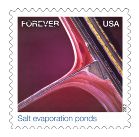
|
Salt is harvested from seawater in evaporation ponds near San Francisco, California. As natural evaporation occurs, salinity levels increase and the concentrations of algae and other microorganisms in the water change, causing the ponds to take on vivid colors. Photo by Barrie Rokeach of Berkeley, CA, 510-527-9470 or 501-918-0809, Barrie@rokeachphoto.com
|
CO
|
Pueblo
|
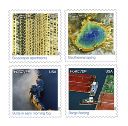
|
Residence of photographer Jim Wark, 719-545-1051, airphotona@comcast.net
|
FL
|
Miami
|

|
In Miami, Interstate Highways 95 and 395 converge in a carefully engineered, multi-level interchange. Off-and-on-ramps convey traffic from one level to another and from one interstate to another at this intricate urban “crossroads.” Stock house photo; unable to locate the name of the photographer.
|
ID
|
|
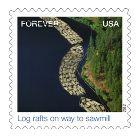
|
“Islands” of wood — log rafts made up of harvested timber — travel by water toward an Idaho mill for processing. This older method of transport has largely died out. Today the timber industry relies on rail and roads to transport trees and tree products from forests to sawmills. Circa 2005 photo taken in Idaho by Tom Brakefield of Hendersonville, TN, 615-822-9477, tbrakefield@comcast.net. Brakefield was as a passenger in an ultra-light aircraft. He encountered steep canyons and strong winds when taking this picture.
|
KS
|
|
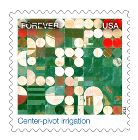
|
Circular patterns on Kansas cropland show center-pivot sprinkler systems have been at work. Red circles indicate healthy, irrigated crops; lighter circles represent harvested crops. Corn, wheat, alfalfa, soybeans, and grain sorghum account for most of the irrigated acreage in Kansas. The stamp art is a detail of an image captured by NASA’s Landsat 7 satellite. Image captured by NASA’s Landsat 7 satellite
|
MA
|
Near Carber
|

|
A Massachusetts cranberry bog holds a bounty of ripe red fruit. During the fall harvest, growers flood bogs, then mechanically churn the water to dislodge cranberries from their low-lying vines. They round up the floating fruit with booms, and convey it to receiving stations for cleaning. Photo by Steve Dunwell of Boston, MA, 617-423-4916, steve@stevedunwell.com
|
MD
|
Blackwater National Wildlife Refuge on Maryland’s Eastern Shore south of Cambridge
|

|
A shallow creek winds through Blackwater National Wildlife Refuge on Maryland’s Eastern Shore. Rich tidal marsh makes up much of the refuge’s more than 25,000 acres, forming a haven for fox squirrels and bald eagles, and a stopping-off point for ducks and geese migrating along the Atlantic Flyway. Photo by Cameron Davidson of Alexandria, VA, 703-845-0547, cameron@camerondavidson.com, cameron.davidson@mac.com
|
MI
|
Park Rapids
|
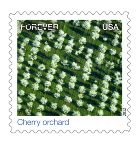
|
Residence of photographer Richard Hamilton Smith of Park Rapids, MI, 218-732-2600, studio@richardhamiltonsmith.com
|
NV
|
Suburbia in Clark County
|

|
Suburbia in Clark County, NV —the state’s most populous county — provides a maze of pavement, sidewalks, and single-family homes. In this desert development, swimming pools and clumps of trees provide some relief from the heat of summer. Stock house photo; photographer contact unavailable.
|
NY
|
West End Towers apartment complex at 75 West End Avenue, New York, NY
|

|
Endless rows of balconies and windows dot the Manhattan cityscape. In this detail of a photograph, the camera’s telephoto lens compresses the distance between the towers of a high-rise. Photo by Jim Wark of Pueblo, CO, 719-545-1051, airphotona@comcast.net
|
PA
|
Steamtown National Historic Site in Scranton
|
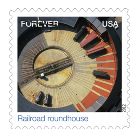
|
Early 20th-century steam locomotives undergo maintenance inside the restored railroad roundhouse and museum. A turntable turns locomotives around and provides access to the roundhouse service stalls. Photo by Jim Wark of Pueblo, CO, 719-545-1051, airphotona@comcast.net
|
TN
|
Henderson
|
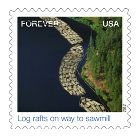
|
Residence of photographer Tom Brakefield, 615-822-9477, tbrakefield@comcast.net. Brakefield was as a passenger in an ultra-light aircraft. He encountered steep canyons and strong winds.
|
TX
|
Houston
|

|
A pair of towboats “wrangle” commercial barges in the Old River barge fleeting area near the Houston Ship Channel in Texas. The channel allows access from the Gulf of Mexico to the Port of Houston, a major industrial center. The photograph of the Apollo (top) and Taurus (bottom, formerly named Marie Cenac) was taken by Jim Wark of Pueblo, CO, 719-545-1051, airphotona@comcast.net
|
UT
|
Monument Valley Navajo Tribal Park in southeastern Utah
|
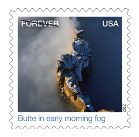
|
Fog rolls in and around Stagecoach butte, one of the many red sandstone formations rising from the floor of the Monument Valley Navajo Tribal Park in southeastern Utah. Snow dusts the rugged crest of the butte. Photo by Jim Wark of Pueblo, CO,
719-545-1051, airphotona@comcast.net
|
VA
|
Alexandria
|

|
Residence of photographer Cameron Davidson, 703-845-0547, cameron@camerondavidson.com, cameron.davidson@mac.com
|
WA
|
Mount St. Helens
|
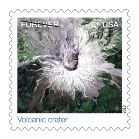
|
Mount St. Helens and its surrounding area continue to recover from the explosive eruption of May 1980. Shades of white and gray indicate still-bare slopes; dark “rivers” are deep channels cut by fast-moving flows of hot ash, rock, and gas. Green represents regrowth of vegetation. The image was captured by NASA’s Landsat 7 satellite. NASA media contact: Rani “Ronnie” Gran, 301-286-2483, rani.c.gran@nasa.gov
|
WI
|
Door County
|
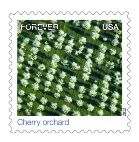
|
Spring is cherry blossom time, and at this cherry orchard in Door County, WI, every tree seems to be in bloom. Door County is known for its tart red cherries, usually harvested from about mid-July to mid-August. Photo by Richard Hamilton Smith of Park Rapids, MI, 218-732-2600, studio@richardhamiltonsmith.com
|
WY
|
Grand Prismatic Spring in Yellowstone National Park
|
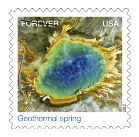
|
At the center of Grand Prismatic Spring in Yellowstone National Park, water temperatures reach nearly 190 degrees — too hot to support most life — but along the edges of the pool, bacteria and algae can thrive, as indicated by the colorful pigments and mats they produce. Photo by Jim Wark of Pueblo, CO, 719-545-1051, airphotona@comcast.net
|
Sample Media Advisory

Contact: [NAME]
[PHONE]
email@usps.gov
www.usps.com/news
[Name] Post Office Dedicates Earthscapes Forever Stamps
[Optional: Local Photographer’s Work Immortalized on Stamp]
High-resolution images of the stamps are available for media use only by emailing
mark.r.saunders@usps.gov
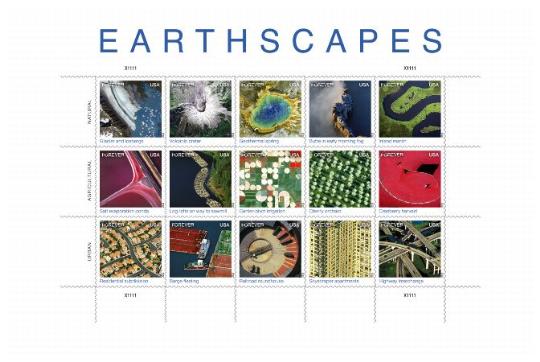
WHAT: Special dedication ceremony for the Earthscapes Forever stamps. The event is free and open to the public.
WHEN: [Time, Day, Date]
WHERE: [Location Name]
[Street Address]
[City, State ZIP+4]
WHO: [Title, Name]
[Title, Name]
BACKGROUND: The Postal Service kicks off October as National Stamp Collecting Month by issuing the Earthscapes Forever stamps. Depicting America’s diverse landscapes on photos taken from ultra-lights to satellites, the stamps provide a view of the nation’s diverse landscapes in a whole new way — from several hundred feet in the sky to several hundred miles in space.
[Additional background on event and or attendees if deemed newsworthy, i.e., stamp photographer, etc.]
# # #
A self-supporting government enterprise, the U.S. Postal Service is the only delivery service that reaches every address in the nation — 151 million residences, businesses and Post Office Boxes. The Postal Service receives no tax dollars for operating expenses, and relies on the sale of postage, products and services to fund its operations. With 32,000 retail locations and the most frequently visited website in the federal government, USPS.com, the Postal Service has annual revenue of more than $65 billion and delivers nearly 40 percent of the world’s mail. If it were a private sector company, the U.S. Postal Service would rank 35th in the 2011 Fortune 500. In 2011, the U.S. Postal Service was ranked number one in overall service performance, out of the posts of the top 20 wealthiest nations in the world, by Oxford Strategic Consulting. Black Enterprise and Hispanic Business magazines ranked the Postal Service as a leader in workforce diversity. The Postal Service has been named the Most Trusted Government Agency for six years and the sixth Most Trusted Business in the nation by the Ponemon Institute.
Follow the Postal Service at www.twitter.com/USPS and at www.facebook.com/USPS.
Sample News Release

FOR IMMEDIATE RELEASE Contact: [NAME]
[DATE] XXX-XXX-XXXX
XXXXXXXX@usps.gov
www.usps.com/news
Aerial, Satellite Photos, Highlight Earthscapes Forever Stamps
[Optional: Local Stamp Photographer Joins in Launching National Stamp Collecting Month]
To obtain a high-resolution image of the stamp for media use only, email mark.r.saunders@usps.gov.
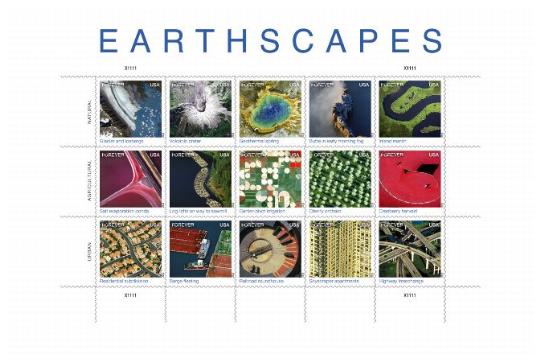
[City, State] — The [Name] Post Office celebrated October as National Stamp Collecting Month with a special dedication ceremony of the Earthscapes Forever stamps that put attendees on cloud nine. [Optional: Highlighting the event were remarks from Earthscapes stamp photographer [Name] who gave the back story on his iconic photograph.”]
“The Earthscapes Forever stamps depict America’s diverse landscapes on photos taken from ultra-lights to satellites,” said [Town Name] Postmaster [Name]. “The stamps provide a view of the nation’s diverse landscapes in a whole new way — from several hundred feet in the sky to several hundred miles in space. [Optional: And we’re excited to have [Name] here to share his story on how he took this inspiring photo and his job as an aerial photographer.”]
Joining [Name] in dedicating the stamps were [Title, Name]; [Title, Name], etc.
[Quote from photographer or other officials here.]
Natural, Agricultural and Urban Perspectives
This stamp pane presents examples of three categories of earthscapes: natural, agricultural and urban. The photographs were all created high above the planet’s surface, either snapped by “eyes in the sky” — satellites orbiting the Earth — or carefully composed by photographers in aircraft.
In the top row, we fly over America’s stunning wilderness. While a volcanic eruption scars the forests of Washington State, fog drifts over the timeless sandstone towers of Utah’s Monument Valley. In Alaska, a wide stripe that looks like a highway is actually a glacier, an immense conveyer belt of ice. At its base, jagged white shards resembling broken glass are really icebergs, bobbing in a lake.
The stamps in the center row may look like abstract art, but they show five products being gathered, grown or harvested: salt, timber, grain, cherries and cranberries. In the middle stamp, center-pivot irrigation systems create geometric shapes — although bystanders on the ground might see only sprinklers in fields of wheat, alfalfa, corn and soybeans.
In the bottom row, urban life takes center stage. Highways corkscrew around themselves and neat subdivisions sport tiny blue pools. It’s our familiar world, shrunken into miniature — and seen with the new eyes that a fresh perspective can bring.
From the power and glory of nature to the interaction of people with the land — in both agricultural and urban settings — each stamp, within its limited amount of space, represents only a fragment of a geographical area, which may or may not be typical of a particular region.
Art director Howard E. Paine designed this educational and visually rich pane of stamps.
Customers may view the Earthscapes Forever stamps, as well as many of this year’s other stamps, indicate which stamps they like and vote for their favorite stamp on Facebook at www.facebook.com/USPSSTAMPS, through Twitter at www.twitter.com/USPSstamps or on the website Beyond the Perf at http://www.beyondtheperf.com/2012-preview. Beyond the Perf is the Postal Service’s online site for background information on upcoming stamp subjects, first-day-of-issue events and other philatelic news.
How to Obtain the First-Day-of-Issue Postmark
Customers have 60 days to obtain the first-day-of-issue postmark by mail. They may purchase new stamps at a local Post Office, at The Postal Store website at usps.com/shop or by calling 800-STAMP-24. They should affix the stamps to envelopes of their choice, address the envelopes to themselves or others and place them in larger envelopes addressed to:
Earthscapes Stamps
Postmaster
7600 Ora Glen Drive
Greenbelt, MD 20770-9998
After applying the first-day-of-issue postmark, the Postal Service will return the envelopes through the mail. There is no charge for the postmark. All orders must be postmarked by Dec. 2, 2012.
How to Order First-Day Covers
The Postal Service also offers first-day covers for new stamp issues and Postal Service stationery items postmarked with the official first-day-of-issue cancellation. Each item has an individual catalog number and is offered in the quarterly USA Philatelic Catalog, online at www.usps.com/shop or by calling 800-782-6724. Customers may request a free catalog by calling 800-782-6724 or writing to:
U.S. Postal Service
Catalog Request
PO Box 219014
Kansas City, MO 64121-9014
Philatelic Products
There are 11 philatelic products available for this stamp issue:
n 470162, First-Day Cover (Full Pane), $9.25.
n 470163, First-Day Cover Set of 15, $13.35.
n 470164, First-Day Cancelled (Full Pane), $9.25.
n 470168, Digital Color Postmark Set of 15, $24.00.
n 470177, Jigsaw Puzzle (includes Earthscapes stamp sheet), $17.95.
n 470184, Press Sheet (without die cut), $60.75. (print quantity of 2,500)
n 470191, Ceremony Program (random single), $6.95.
n 470192, Stamp Deck Card, $0.95.
n 470194, Stamp Deck Card w/Digital Color Postmark (DCP) (random single), $1.95.
n 470197, Commemorative Stamp Panel, $16.95.
n 470199, Cancellation Keepsake (random DCP w/Pane), $8.95.
The Postal Service receives no tax dollars for operating expenses and relies on the sale of postage, products and services to fund its operations.
# # #
Note: For broadcast quality video and audio, photo stills and other media resources, visit the USPS Newsroom at http://about.usps.com/news/welcome.htm.
For reporters interested in speaking with a regional Postal Service public relations professional, go to http://about.usps.com/news/media-contacts/usps-local-media-contacts.pdf.
A self-supporting government enterprise, the U.S. Postal Service is the only delivery service that reaches every address in the nation — 151 million residences, businesses and Post Office Boxes. The Postal Service receives no tax dollars for operating expenses, and relies on the sale of postage, products and services to fund its operations. With 32,000 retail locations and the most frequently visited website in the federal government, USPS.com, the Postal Service has annual revenue of more than $65 billion and delivers nearly 40 percent of the world’s mail. If it were a private sector company, the U.S. Postal Service would rank 35th in the 2011 Fortune 500. In 2011, Oxford Strategic Consulting ranked the U.S. Postal Service number one in overall service performance of the posts in the top 20 wealthiest nations in the world. Black Enterprise and Hispanic Business magazines ranked the Postal Service as a leader in workforce diversity. The Postal Service has been named the Most Trusted Government Agency for six years and the sixth Most Trusted Business in the nation by the Ponemon Institute.
Follow the Postal Service at www.twitter.com/USPSstamps and at www.facebook.com/USPSSTAMPS.
Sample Speech
[Postal Service official’s name and title]
United States Postal Service
Earthscapes
Special Dedication Ceremony
[Date]
[City, State]
Good [Morning/Afternoon/Evening]. My name is [Name] and I’m [Title] for the United States Postal Service. Welcome to this event.
or:
Thank you, [Name], for your kind introduction. And thank you all for joining us for this event. [Optional: Add a brief comment about how this location relates to the Earthscapes stamps]
I also want to thank our special guests for joining us in [City/Town/Type of Setting].
In particular, I’m glad that our good friend(s) [Name of Elected Official] is here, along with [Other Individuals Who Should Be Recognized].
We’re here today to dedicate a new pane of stamps that celebrate the wonders of the American terrain.
Our new pane of 15 Earthscapes stamps offer a bird’s eye view of the land we all share.
Each stamp’s unique perspective makes it a window into a world most of us never get to see.
[From the list of 15 bullet points below, choose a few examples. If any of these examples are relevant to your area, you might want to start there.]
n One Earthscapes stamp depicts a Yellowstone National Park geothermal spring where the temperatures reach almost 190 degrees, making it too hot for humans. But that doesn’t mean it’s lifeless. As we look at the image on the stamp, we see colorful pigments produced by bacteria and algae, which thrive in environments like this.
n One Earthscapes stamp shows a Northern California salt evaporation pond, where we see how rising salinity levels have transformed the microorganisms below the surface. The result is a series of vivid reds, pinks, and purples, framed by brilliant yellow.
n We find artistry in the Earthscapes stamp that shows a high-rise apartment complex on Manhattan’s Upper West Side. And when we say “complex,” we’re not kidding: This image offers an endless row of balconies and windows, all cast against a grid of yellow brick.
n One Earthscapes stamp shows ice breaking from the foot of Alaska’s Bear Glacier and becoming icebergs in a lake. The result: streaks of white cast against a background of brilliant blues and deep earth tones.
n In the Earthscapes stamp that depicts Mount Saint Helen in Washington State, we see how the area is still recovering from the eruption of 1980. Shades of white and gray indicate still-bare slopes, while flashes of green illustrate the re-growth of vegetation.
n On one Earthscapes stamp, we see Stagecoach Butte, one of the many red sandstone formations rising from the floor of the Monument Valley Navajo Tribal Park in southeastern Utah. The fog rolling across the terrain lends this image an aura of mystery and natural intrigue.
n The Earthscapes stamp that depicts the Blackwater National Wildlife Refuge on Maryland’s Eastern Shore shows a shallow creek of deep blue water winding through bright green marshland. This is a haven for fox squirrels and bald eagles and a stopping-off point for ducks and geese migrating along the Atlantic Flyway.
n Log rafts are seen floating their way to an Idaho sawmill on one of the Earthscapes stamps. This offers a window into the past because this method of transport has largely died out. Today, the timber industry relies on rail and roads to transport tree products from forests to sawmills.
n The Earthscapes stamp that depicts circular patterns on Kansas cropland show where sprinkler systems have been at work. Each circle tells a story: the red circles indicate healthy, irrigated crops, while the lighter circles show crops that have been harvested.
n A sure sign of springtime is seen in the Earthscapes stamp that shows a cherry orchard in Door County, Wisconsin. This area is known for its tart red cherries, and in this beautiful image, it seems as if every tree is in bloom.
n One of the Earthscapes stamps looks like a mass of brilliant red, but look closely and you realize you’re looking at a cranberry bog. The image shows two growers rounding up the floating fruit during a fall harvest in Massachusetts.
n On one of the Earthscapes stamps, we see a pair of towboats wrangling commercial barges in the Old River barge fleeting area near the Houston Ship Channel in Texas. In this image, the barges — cast in shades of red, green, and orange — pop against the deep blue background.
n One of the Earthscapes stamps looks like a series of circles, colored in shades of orange and gray. Scrutinize it a little more closely and you discover you’re actually looking at a railroad roundhouse. The image, captured in Scranton, Pennsylvania, shows the giant turntable that is used to turn around early 20th century locomotives when they undergo maintenance.
n Motorists in Miami may recognize one of the Earthscapes stamps, although they may have never seen it like this before. The image shows where Highways 95 and 395 converge in a carefully engineered, multi-level interchange. It’s an aerial view of one of America’s urban crossroads.
n One of the Earthscapes stamps offers a unique look at suburbia. In the image, we see a maze of pavement, sidewalks, and single-family homes in Clark County, Nevada, the state’s most populous county. Look closely and you’ll also see the swimming pools and clumps of trees that provide summertime relief in this desert development.
Some of the pictures on the Earthscapes stamps were taken by satellites. These include NASA’s Landsat 7 satellite, which orbits the earth at an altitude of about 705 kilometers, or roughly 435 miles.
Other Earthscapes images were taken by photographers like Jim Wark, who contributed several pictures to this pane of stamps.
In addition to showcasing stunning photography, Earthscapes continues the Postal Service’s long tradition of portraying our environment on stamps.
For example, between 1999 and 2009, we offered Scenic American Landscapes stamps that depicted the Rio Grande, Yosemite National Park, and other natural landmarks.
Like those offerings, these new Earthscapes stamps depict nature at its best and signal the importance of preserving our planet for future generations.
In that spirit, we’re offering the Earthscapes stamps as Forever stamps. They’ll always be good, no matter what the postage rate might be.
So we encourage customers like you to purchase these stamps and affix them to your cards, letters, and packages.
Because each time you do, you’ll help remind the world of the enduring beauty offered by the earthscapes around us.
Thank you.
(Pause for applause)
Now, on behalf of the United States Postal Service, I want to invite everyone on stage to join me in dedicating the Earthscapes Forever stamps.
(Unveil stamp. Pose for photos.)
Earthscapes Stamp Image Contacts
For image blowups for events: Maggie Kasper at Dodge Chrome, Maggie@dodgechrome.com, 240-247-1814.
For high-resolution images for media use only: mark.r.saunders@usps.gov.
Area Corporate Communications Managers
Capital Metro
George Maffett
george.t.maffett@usps.gov
301-548-1465
Eastern
Paul Smith
paul.f.smith@usps.gov
215-863-5055
Great Lakes
Victor Dubina
victor.dubina@usps.gov
216-443-4596
Pacific
Don Smeraldi
don.a.smeraldi@usps.gov
858-674-3149
Northeast
Maureen Marion
maureen.p.marion@usps.gov
860-285-7029
Southwest
Earl Artis
earl.c.artis@usps.gov
214-819-8704
Western
Teresa Rudkin
teresa.rudkin@usps.gov
303-313-5130
Congressional State Representative Listing
202-268-xxxx
— Public Relations,
Corporate Communications, 9-20-12
